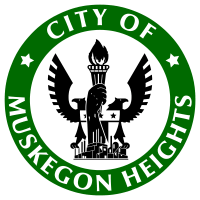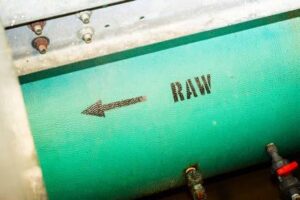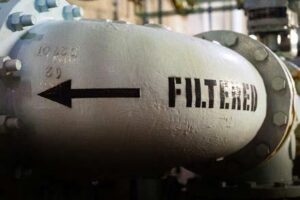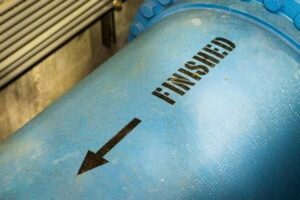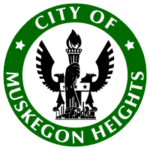
Derrick Johnson

This report covers the drinking water quality for the City of Muskegon Heights (Water Supply Serial Number 04580) for the 2024 calendar year. This information is a snapshot of the quality of the water that we provided to you in 2024. Included are details about where your water comes from, what it contains, and how it compares to United States Environmental Protection Agency (U.S. EPA) and state standards. Our constant goal is to provide you with a safe and dependable supply of drinking water.
Water Source
Your water is surface water from Lake Michigan and is treated at the City of Muskegon Heights Water Filtration Plant. The State performed an assessment of our source water to determine the susceptibility or the relative potential of contamination. The susceptibility rating is on a seven-tiered scale from “very-low” to “very-high” based on geologic sensitivity, water chemistry, and contamination sources. The susceptibility of our source is moderately high. If you would like to know more about this report, please contact The City of Muskegon Heights Water Filtration Plant at 231-780-3415.
Sources of Drinking Water
The sources of drinking water (both tap water and bottled water) include rivers, lakes, streams, ponds, reservoirs, springs, and wells. Our water comes from Lake Michigan. As water travels over the surface of the land or through the ground, it dissolves naturally-occurring minerals and, in some cases, radioactive material, and can pick up substances resulting from the
presence of animals or from human activity.
In order to ensure that tap water is safe to drink, the U.S. EPA prescribes regulations that limit the levels of certain contaminants in water provided by public water systems. Federal Food and Drug
Administration regulations establish limits for contaminants in bottled water which provide the same protection for public health.
Contaminants That May Be Present in
Source Water
- Microbial contaminants, such as viruses and bacteria, which may come from sewage treatment plants, septic systems, agricultural
livestock operations, and wildlife.
- Inorganic contaminants, such as salts and metals, which can be naturally-occurring or result from urban stormwater runoff, industrial
or domestic wastewater discharges, oil and gas production, mining, or farming.
- Pesticides and herbicides, which may come from a variety of sources such as agriculture and residential uses.
- Radioactive contaminants, which can be naturally occurring or be the result of oil and gas production and mining activities.
- Organic chemical contaminants, including synthetic and volatile organic chemicals, which are by-products of industrial processes and
petroleum production, and can also come from gas stations, urban stormwater runoff, and septic systems.
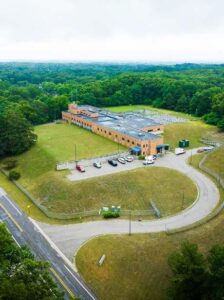
Contaminants and Their Presence in
Water
Drinking water, including bottled water, may reasonably be expected to contain at least small amounts of some contaminants.
The presence of contaminants does not necessarily indicate that water poses a health risk. More information about contaminants and potential health effects can be obtained by calling the U.S. EPA’s Safe Drinking Water Hotline (800-426-4791).
Vulnerability of sub-populations
Some people may be more vulnerable to contaminants in drinking water than the general population. Immuno-compromised persons such as persons with cancer undergoing chemotherapy, persons who have undergone organ transplants, people with HIV/AIDS or other immune system disorders, some elderly, and infants can be particularly at risk from infections. These people should seek advice about drinking water from their health care providers. U.S. EPA/Center for Disease Control guidelines on appropriate means to lessen the risk
of infection by Cryptosporidium and other microbial contaminants are available from the Safe Drinking Water Hotline (800-426- 4791).
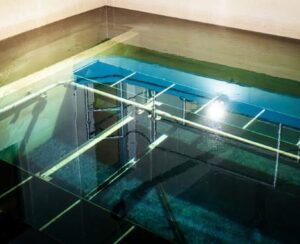
Water Quality Table Key and Definitions
- Maximum Contaminant Level Goal (MCLG): The level of a contaminant in drinking water below which there is no known or expected risk
to health. MCLGs allow for a margin of safety.
- Maximum Contaminant Level (MCL): The highest level of a contaminant that is allowed in drinking water. MCLs are set as close to the
MCLGs as feasible using the best available treatment technology.
- Maximum Residual Disinfectant Level (MRDL): The highest level of a disinfectant allowed in drinking water. There is convincing
evidence that addition of a disinfectant is necessary for control of microbial contaminants.
- Maximum Residual Disinfectant Level Goal (MRDLG): The level of a drinking water disinfectant below which there is no known
or expected risk to health. MRDLGs do not reflect the benefits of the use of disinfectants to control microbial contaminants.
- Treatment Technique (TT): A required process intended to reduce the level of a contaminant in drinking water.
- N/A: Not applicable
- ND: not detectable at testing limit
- ppm: parts per million or milligrams per liter
- ppb: parts per billion or micrograms per liter
- ppt: parts per trillion or nanograms per liter
- Action Level (AL): The concentration of a contaminant which, if exceeded, triggers treatment or other requirements that a water
system must follow.
- Turbidity: A measure of the clarity of the water. We monitor it because it is a good indicator of the effectiveness of our filtration process.
- NTU: Nephelometric Turbidity Unit: Measurements of the minute suspended particles in the water. Used to judge water
clarity.
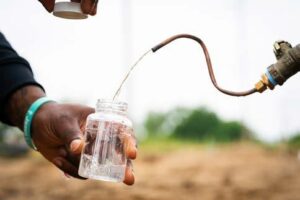
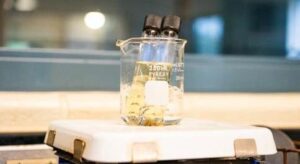
2024 Water Quality Data
The State of Michigan and the U.S. EPA require us to test our water regularly to ensure its safety. The table below lists all the drinking water contaminants that we detected during the 2024 calendar year. The presence of these contaminants in the water does not necessarily indicate that the water poses a health risk.
Unless otherwise noted, the data presented in this table is from testing done January 1
through December 31, 2024. The State allows us to monitor for certain contaminants less than once per year because the concentrations of these contaminants are not expected to vary significantly from year to year. All the data is representative of the water quality, but some are more than one year old.
Regulated at the Treatment Plant
| Substance | MCL or TT | MCLG | Level Detected | Range | Sample Year | Violation | Typical Source |
|---|---|---|---|---|---|---|---|
| Barium (ppm) | 2 | 2 | 0.02 | N/A | 2019 | No | Discharge from drilling wastes; discharge from metal refineries; erosion of natural deposits |
| Cryptosporidium (oocysts/L)¹ | N/A | N/A | 1 | 0–1 | 2017 | No | Naturally Present in the Environment |
| Fluoride (ppm) | 4.0 | 4.0 | 0.34 | N/A | 2024 | No | Erosion of natural deposits; Water additive which promotes strong teeth; Discharge from fertilizer and aluminum factories |
| Nitrate (ppm) | 10 | 10 | 0.54 | N/A | 2024 | No | Runoff from fertilizer use; Leaking from septic tanks, sewage; Erosion of natural deposits |
| PFHxA (ppt)² | 400,000 | N/A | 0.7 | 1.1–1.4 | 2024 | No | Firefighting foam, discharge, and waste from industrial facilities |
| PFHxS (ppt)² | 51 | N/A | ND | N/A | 2024 | No | Firefighting foam, discharge, and waste from industrial facilities |
| PFBS (ppt)² | 420 | N/A | ND | N/A | 2024 | No | Discharge and waste from industrial facilities, stain-resistant treatment |
| PFNA (ppt)² | 6 | N/A | ND | N/A | 2024 | No | Discharge and waste from industrial facilities, breakdown of precursor compounds |
| HFPO-DA (ppt)² | 370 | N/A | ND | N/A | 2024 | No | Discharge and waste from industrial facilities utilizing the Gen X chemical process |
| PFOA (ppt)² | 8 | N/A | 1.0 | 1.2–2.0 | 2024 | No | Discharge from waste and industrial facilities; stain-resistant treatments |
| PFOS (ppt)² | 16 | N/A | 2.4 | 1.6–2.6 | 2024 | No | Firefighting foam, discharge from electroplating facilities, discharge and waste from industrial facilities |
| Total Organic Carbon (TOC) | TT | N/A | 31% removal, 25% required | 25–37% | 2024 | No | Naturally present in the environment |
| Turbidity (ntu)³ | 1 (TT) | N/A | 0.12 | N/A | 2024 | No | Soil runoff |
² The level detected for this substance is reported as the maximum running annual average (RAA) in 2024.
³ Turbidity is a measure of the cloudiness of the water. We monitor it because it is a good indicator of the effectiveness of our filtration system. Turbidity must also be ≤0.3 ntu for 95% or more of measurements each month. 100% of the samples each month were ≤0.3 ntu.
Cryptosporidium and Drinking Water
Cryptosporidium is a microbial parasite that is found in surface water throughout the U.S. Although Cryptosporidium can be removed by filtration, the most commonly used filtration methods cannot guarantee 100 percent removal. Monitoring of our source water indicates the presence of these organisms. Current test methods do not enable us to determine if these organisms are dead or if they are capable of causing disease. Symptoms of infection include nausea, diarrhea, and abdominal cramps. Most healthy individuals are able to overcome the disease within a few weeks. However, immuno-compromised people have more difficulty and
are at greater risk of developing sever, life threatening illness. Immuno-compromised individuals are encouraged to consult their doctor regarding appropriate precautions to take to prevent infection. Cryptosporidium must be ingested for it to cause disease, and may be passed through other means than drinking water.
Regulated in the Distribution System
| Substance | MRDL or MCL | MRDLG or MCLG | Level Detected | Range | Sample Year | Violation | Typical Source |
|---|---|---|---|---|---|---|---|
| Chlorine (ppm) | 4 | 4 | 1.07 | 0.03–1.93 | 2024 | No | Water additive used to control microbes |
| Total trihalomethanes (ppb) | 80 | N/A | 53 | 31–77 | 2024 | No | Byproduct of drinking water disinfection |
| Haloacetic acids (ppb)² | 60 | N/A | 39.3 | 17.0–57.4 | 2024 | No | Byproduct of drinking water disinfection |
Regulated at Customers’ Taps
| Substance | AL | MCLG | Your Water | Range | Sample Year | Number of Samples Above AL | Typical Source |
|---|---|---|---|---|---|---|---|
| Lead (ppb) | 15 | 0 | 2.8 | 0–14 | 2023 | 0 | Lead service lines, corrosion of household plumbing, including fittings and fixtures; erosion of natural deposits |
| Copper (ppm) | 1.3 | 1.3 | 0.082 | 0–0.6 | 2023 | 0 | Corrosion of household plumbing systems; erosion of natural deposits |
Information About Lead
Lead can cause serious health effects in people of all ages, especially pregnant people, infants (both formula-fed and breastfed), and young children. Lead in drinking water is primarily from materials and parts used in service lines and in home plumbing. City of Muskegon Heights is responsible for providing high quality drinking water and removing lead pipes but cannot control the variety of materials used in the plumbing in your home. Because lead levels may vary over time, lead exposure is possible even when your tap sampling results
do not detect lead at one point in time. You can help protect yourself and your family by identifying and removing lead materials within your home plumbing and taking steps to reduce your family’s risk. Using a filter, certified by an American National Standards Institute accredited certifier to reduce lead, is effective in reducing lead exposures. Follow the instructions provided with the filter to ensure the filter is used properly. Use only cold water for drinking, cooking, and making baby formula. Boiling water does not remove lead from water. Before using tap water for drinking, cooking, or making baby formula, flush your pipes for several minutes. You can do this by running your tap, taking a shower, doing laundry or a load of dishes. If you have a lead service line or galvanized requiring replacement service line, you may need to flush your pipes for at least 5 minutes to flush water from both your home plumbing and the lead service line. If you are concerned about lead in your water and wish
to have your water tested, contact City of Muskegon Heights Water Filtration at 231-780-3415 for available resources. Information on lead in drinking water, testing methods, and steps you can take to minimize exposure is available at
https://www.epa.gov/safewater/lead
Our water supply has 3,530 lead service lines and no unknown service lines out of a total of 5,107 service lines.
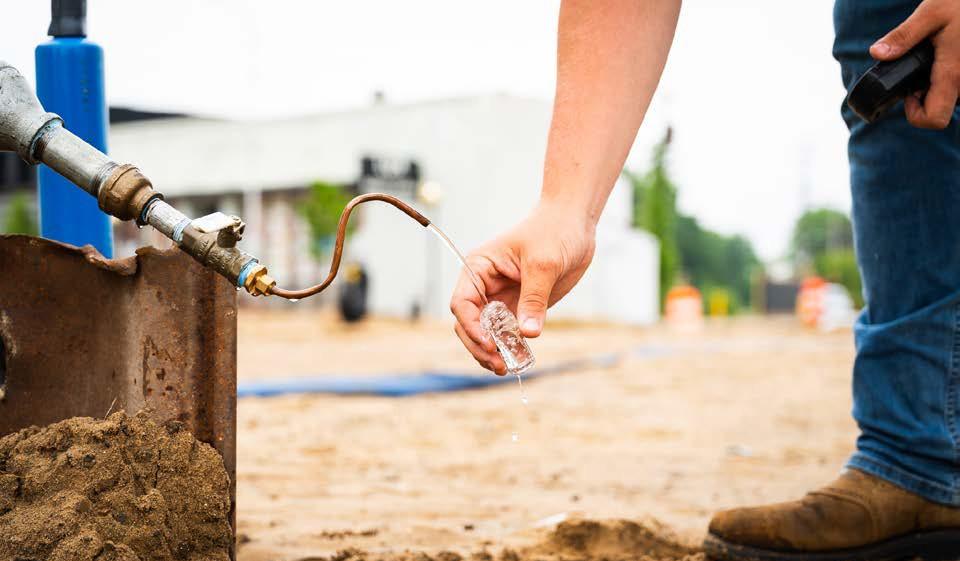
Additional Monitoring
The following are unregulated contaminants are those for which the U.S. EPA has not established drinking water standards.
Monitoring helps the U.S. EPA determine where certain contaminants occur and whether regulation of those contaminants is needed.
| Substance | Average Level | Range | Sample Year | Typical Source |
|---|---|---|---|---|
| Sodium (ppm) | 15 | N/A | 2024 | Naturally present in the environment |
| PFBA (ppt)¹ | 1.35 | 1.2–1.5 | 2024 | Firefighting foam, discharge from electroplating facilities, discharge and waste from industrial facilities |
| PFPeA (ppt)¹ | 1.4 | 1.4 | 2024 | Firefighting foam, discharge from electroplating facilities, discharge and waste from industrial facilities |
| PFHpA (ppt)¹ | 1.1 | 1.1 | 2024 | Discharge from waste and industrial facilities; stain-resistant treatments |
Water Quality Report & Public Input
We will update this report annually and will keep you informed of any problems that may occur throughout the year, as they happen. This report will be sent to you.
Copies are available at City of Muskegon Heights City Hall, 2724 Peck Street, Muskegon Heights, MI 49444, online at http://www.cityofmuskegonheights.us, or by calling the Water Filtration Plant at 231-780-3415. Additionally, check out the Muskegon Heights mobile app that allows you to access the report and stay updated on any important information.
The Muskegon Heights City Council encourages community involvement in decisions regarding drinking water quality. Council meetings are held every Monday at 5:30 p.m. in the Council Chambers located at City Hall in Muskegon Heights. For inquiries about your drinking water or details related to this report, please reach out to the Water Filtration Plant at 231-780-3415. Additionally, for more comprehensive information on safe drinking water, you can visit the U.S. EPA website. http://www.epa.gov/safewater
Violation Notices
Significant Deficiency Violation Notice
EGLE issued a significant deficiency violation notice to the City on February 17, 2023 noting that the City lacks the technical, managerial, and financial (TMF) capacity to support a water utility. The violation notice identified the following areas for correction: Water system staffing, Water Filtration Plant maintenance, Water Filtration Plant equipment reliability, Water Filtration
Plant capacity, instrumentation calibrations, chlorine analyzer, pump reliability, and financial capacity. The city has undergone critical repairs to fix broken equipment, resulting in improved reliability, increased capacity, and better pump performance. Issues with instrument calibrations and the chlorine analyzer have been resolved.
The city is collaborating with EGLE to establish a schedule and corrective action plan to address all identified deficiencies fully.
Failure of Monitoring Equipment
During the period from November 26, 2024, to December 4, 2024, a Tier 3 violation occurred due to the failure of the chlorine monitoring equipment. This equipment is crucial for measuring chlorine levels in the water system to ensure proper disinfection. Although manual measurements did not indicate low chlorine levels, it is important to note that they are not collected continuously. The online instrument
was not repaired within the required five days, as
stipulated by EGLE regulations.
A replacement chlorine analyzer has been installed, and during the time the analyzer was down, we established a camera to monitor its status at night. Water Plant Operators monitor the analyzer daily to ensure it operates correctly.
Additionally, we have implemented analyzers at several more sample points to enhance our monitoring efforts.
Professional and Certified Waterworks System Operators




